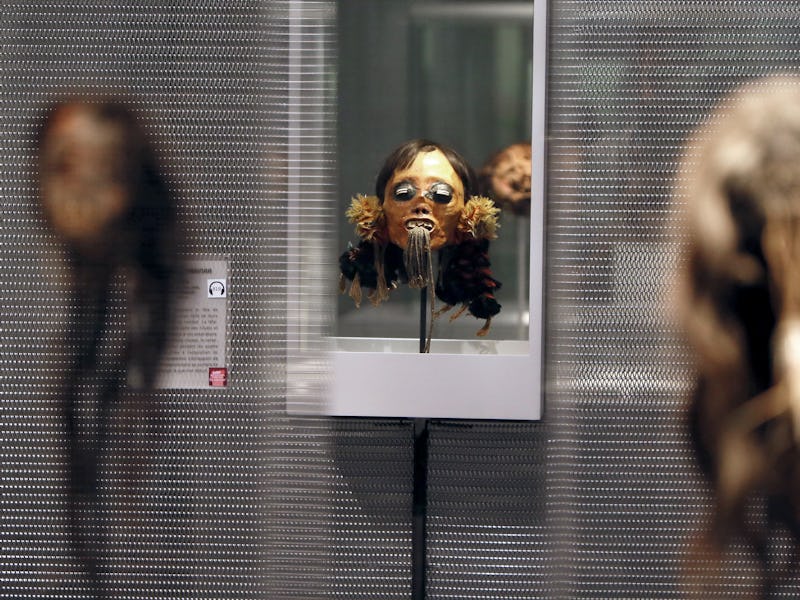X-Ray study adds to the mystery shrouding shrunken heads’ origins
New research contradicts what were once considered tell-tale signs of an authentic or forged artifact.

If you’ve ever felt like you’re being watched while strolling through a museum, these small, intricate artifacts may be the culprit: Just over 3 inches tall with leathery skin and long, often luscious hair, tsantsas (commonly referred to in English as shrunken heads) hang inside display cases at museums around the world, far away from their homes with the Shuar and Achuar peoples in Ecuador and Northern Peru.
During the 19th and 20th centuries, colonists viewed tsantsas as intriguing collectibles and purchased them with guns, sparking widespread violence. Amid a worldwide reckoning with systemic racism in 2020, the University of Oxford’s Pitt Rivers Museum removed a tsantsa display that they felt “reinforced racist and stereotypical thinking” of other cultures, portraying them as “savage, primitive or gruesome.” These items likely included four forged objects crafted from bodies stolen from morgues or hospitals, The Guardian reported.
Despite their widespread presence in Western museums, the true origin of many tsantsas is murky, says Lauren Poeta, an associate at Western University’s Office of Indigenous Initiatives in Canada and a former anthropology master’s student. This research is part of Poeta’s broader work on funerary artifacts and Andean archaeology.
“There are no original records from the Shuar/Achuar peoples themselves of the process as it was a sacred ceremony, rather there’s a series of inconsistent and sometimes opposing accounts by missionaries, settlers, explorers,” Poeta tells Inverse.
“Colonial processes, inconsistent settler narratives, and the mass creation and export of commercial shrunken heads led to where we are now, where it is hard to determine the true origin of the vast majority of tsantsas.”
Poeta’s team used traditional and more precise micro-CT technology to examine the tiny details of a tsantsa of Peruvian origin, ultimately creating this 3D-rendered image.
Determining an “authentic,” or ceremonially made tsantsa, from an “inauthentic,” or commercially made tsantsa, has proven difficult, even when using modern tools like computational tomography (the kind of CT scan you might undergo at a hospital) to peer inside their heads.
In a new paper published Wednesday in the journal PLOS One, Poeta and colleagues have taken a closer look — literally — by employing a mix of traditional and more precise micro-CT technology to study the minute differences between authentic and inauthentic tsantsas. The team studied a tsantsa of Peruvian origin donated to Canada’s Chatham-Kent Museum in the 1940s.
This approach helped the team see the construction of tsantsas in a new light. But it also offered an unexpected result: The study may have redefined the criteria for an authentic versus a forged tsantsa.
Here’s the background — While historical accounts of tsantsa production tell conflicting tales, Poeta and colleagues explain in their paper that traditionally there are two main categories:
- Authentic tsantsas, made from human remains to capture the soul of one’s vanquished enemy
- Inauthentic tsantsas, likely made from animal remains to sell to European visitors
Accounts also claim that tiny details in craftsmanship may also differ, such as how incisions into the skull were made and the type of hair used. By magnifying these features, Poeta and colleagues hope to discern the real from the fake.
Why it matters — While Victorian-era European settlers may have considered tsantsas merely “curios,” Poeta stresses that these artifacts hold great importance among the Shuar and Achuar people. By better understanding the origin and practices of these tsantsas, researchers can shed light on the “history, culture, rituals, and identity” of these communities, Poeta says.
Pinning down the origins of the tsantsa may also be important for the future repatriation of these artifacts. In 2019, similar research from Mercer University led to the repatriation of an Ecuadorean tsantsa that had been used as a prop in the 1979 John Huston film Wise Blood.
How the discovery was made — To take their measurements, Poeta and colleagues used a “scout and zoom” approach. They began with traditional CT to provide a larger view of the tsantsa before using micro-CT to zero in on tell-tale craftsmanship. In both cases, the CT scans worked by generating a 3D model of the tsantsa via bounced-back X-rays and then slicing the model into slabs for 2D analysis.
Instead of settling on a tidy answer regarding the origin of this tsantsa, the team found that it appeared to include elements associated with authentic and inauthentic construction. Namely, while the tsantsas incision and stitching appear inauthentic, its remains and hair seemed to be of human origin.
The researchers were shocked to learn that the artifact included elements associated with both authentic and inauthentic construction.
“Each tsantsa is very unique, and we can’t look at the production of tsantsas as a monotonous dichotomy if we want to truly understand the history, culture, rituals, and identity that are materially represented through tsantsas,” Poeta says.
What’s next — In many cases, the history of tsantsas construction may be a bit more complicated than scientists originally thought.
Future research from Poeta’s colleagues will include DNA analysis of tsantsas and even potential scans of the entire structure at micro-CT resolution — that is, if computers used for this analysis advance to swiftly handle these 115+ GB datasets.
Ultimately, the next step of this research, including repatriation decisions, will be determined by the wishes of the Shuar and Achuar people, Poeta says.
This article was originally published on